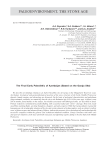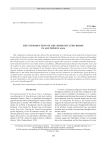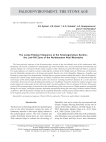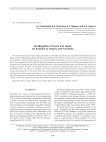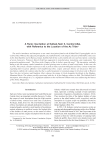Archaeology, Ethnology & Anthropology of Eurasia @journal-aeae-en
Статьи журнала - Archaeology, Ethnology & Anthropology of Eurasia
Все статьи: 524

The emergence of levallois blade industry in the western foothills of Tien Shan: Kulbulak layer 24
Статья научная
We describe fi nds from layer 24 of Kulbulak, Western Tien Shan, excavated in 2018–2019. On the basis of the age of layer 16 (MIS 5e) and the geological context of the deposits, the profi le of the site was subdivided into paleogeographic stages. Layers 25–22 likely correlate with the warming period in the second half of MIS 7. Primary reduction in layer 24 industry was based on parallel uni- and bidirectional techniques, with wide and narrow-faced cores, and following the Levallois strategy. Tools include various side-scrapers, a point on a heavily retouched blade, a retouched blade, an atypical angular end-scraper, and blanks of bifaces. Parallels are found between those fi nds and contemporaneous industries of the Near East. Technologically and likely chronologically, layer 24 is intermediate between Late Amudian and Early Middle Paleolithic assemblages of the Tabun D stage. This is evidenced by a combination of non-Levallois and Levallois fl aking (the latter being predominant), by different types of blanks within the same reduction sequence, by a high share of blades among blanks, by bifacial pieces, by an elongated heavily retouched point, and by an atypical end-scraper.
Бесплатно
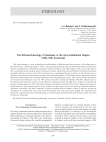
The ethnoarchaeology of Russians in the Syro-Palestinian region (18th-19th centuries)
Статья обзорная
Бесплатно
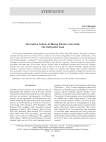
The festive culture of mining plants in the Urals: the Dobryanka case
Статья научная
On the basis of documentary ethnographic sources from the late 19th to early 20th centuries, the study reconstructs calendar festivals and rites of that period, recorded at one of the mining plants in the Urals—Dobryanka, in the western part of the Perm Governorate. Common festivals celebrated at Uralian mining plants include the greeting of birds (kashke-plishke), “sending off” water (seeing off the Kama), Day of St. Sergius, Pentecost, etc. The industrial calendar was related to the main household and holiday cycles; special “corporate” festivals emerged at private plants, coinciding with name-days of the plants’ owners; archaic forms of traditional ritualism were preserved; calendar festivals were more and more regarded as forms of leisure with less and less religious meaning; multiple calendar traditions coexisted; and new urban forms of festive culture were adopted. The holiday culture of plant settlements was intermediate between rural and urban forms of calendar ritualism. Each peculiarity of industrial calendar rites is described using ethnographic examples from the corresponding holiday cycle. The findings indicate rather unusual features of folk culture in the industrial settlements of the Urals.
Бесплатно

The final Bronze Age in the Minusinsk basin
Статья научная
Based on the most recent excavation fi ndings, this article discusses a disputable group of burials, previously believed to represent the Bainov stage of the Tagar culture (900–700 BC) in the Minusinsk Basin. Analysis of these burials unambiguously supports I.P. Lazaretov’s idea that they fall into two independent and unrelated groups. One of them continues Late Bronze Age traditions, whereas the other demonstrates new features exclusively associated with the Tagar culture. Most complexes of the Bainov type represent the fi nal stage in the evolution of Late Bronze Age traditions. This is evidenced by various categories of grave goods, features of burial structures, and the funerary rite. These burials can be attributed to stage IV of the Late Bronze Age in the Minusinsk Basin. The second, smaller group reveals entirely new features, typical of the Podgornoye stage of the Tagar culture. These include novel structural features in kurgan architecture, different female funerary attire, and the custom of placing weapons in graves. This attests to the arrival of a new population group with its own traditions, resulting in the emergence of a Scythian type culture on the Middle Yenisey. These burials should be attributed to the beginning of the Podgornoye stage of the Tagar culture. Hopefully, future studies will help to separate out a special late group of Bainov burials, contemporaneous with the early Podgornoye kurgans. Currently, it is possible to discern certain features suggesting that this population took part in the origin of the Tagar culture.
Бесплатно
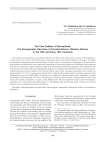
Статья научная
Sex and age were determined in a skeletal sample from an 18th to early 19th century cemetery at Krivoshchekovo, a rural center since the mid-1790s. Historical records mention the area as the Krivoshchekovo Ob region. The village was founded by immigrants from European Russia. Archival sources concerning the demography of Krivoshchekovo were analyzed, mortality tables were constructed, proportions of various age groups were calculated, and average age of death was estimated for adults. Limitations of the study stem from the fact that the population of Krivoshchekovo was not stationary. The results of the paleodemographic analysis are compared with information from two archival sources: confessional lists and parish registers of St. Nicholas Church, where births, marriages, and deaths were recorded over the period from 1763–1841. Comparative material relates to Russian old residents and the local Tatar population of the Omsk Irtysh region in the 1600s–1800s. Sex and age were estimated in a skeletal sample of 462 individuals—one third of the number of deaths during 1763–1841, when people were buried at the graveyard. Child mortality was lower than among old residents, immigrants, or natives of the Middle Irtysh. The most vulnerable group in the Krivoshchekovo population were young women and children aged 1–4. The findings of the skeletal study agree with those derived from archival sources, and likely mirror the real situation.
Бесплатно
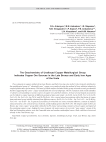
Статья научная
Trace elements in copper artifacts from Late Bronze and Early Iron Age sites in the Urals, formerly attributed to the metallurgical group of “chemically pure” copper, were analyzed using the method of laser ablation inductively coupled plasma mass spectrometry. The metal of which artifacts included in this group are made reveals geochemical markers suggesting that “pure” copper actually falls into several subgroups. The PCA analysis of the results identifies 11 clusters corresponding to various sources of copper ores and their mixtures. At least seven principal associations can be linked to copper deposits of different geological types and origin: Au-Te-Bi, Au-Se-Te-Sb, Fe-Co-Ni-As-Sb, Fe-Co-Ni -Zn, Se-Co-Fe, Ag-Pb-Ni, and Sb-Pb-Zn-As. Also, several mixed associations reflect the fusion of copper items and metal scrap initially obtained from different sources: Sn-Pb, Fe-Co-Ni-Zn + Sn, Fe-Co-Ni + Au-Te-Bi-Ag, Fe-Co-Ni + Au-Te-Bi + Sn. A separate association, for which the ore source remains unknown, consists of artifacts characterized by a low content of trace elements, jointly making up less than 0.01 wt%. The largest sample in the Late Bronze Age “pure copper” group falls within the Sn-Pb cluster representing a mixture of local copper and imported Sn-containing copper scrap. Judging by trace elements, the main sources of ore in the “pure copper” group of the Itkul and Sarmatian cultures were the Gumeshki mine and another unidentified source. Both could have been used already in the Final Bronze Age.
Бесплатно
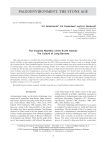
The incipient Neolithic of the Kurile islands: the culture of long barrows
Статья научная
This study introduces a recently discovered Neolithic culture of insular Northeast Asia. The initial stage of the Kurile Neolithic is described using findings from the 2019–2020 excavations at Kitovyi-2 and -4 on Iturup Island, the Greater Kurile Chain, Sakhalin Region. Several types of Neolithic feature were first revealed on the Kuriles by excavating large areas. The site includes dwellings mostly of two types–terranean with wooden frames that are not dug into the ground, and semisubterranean. Artifacts include linear-relief pottery and retouched bifacial stone tools on flakes and entire singularities, processed by advanced polishing. For the first time on the Kuriles, long barrows encircled by basalt plates along the perimeter were detected. These structures with evidently non-utilitarian enclosures made of plates, tentatively identified as places for cremation burials and funerary rites, indicate symbolic behavior. On the basis of this key criterion, we propose to attribute Kitovyi-2 and -4 to the culture of long barrows. Stratigraphic evidence, supported by radiocarbon analysis, allows us to establish the initial stage of the Kurile Neolithic, dating to 13.0–8.5 cal ka BP.
Бесплатно
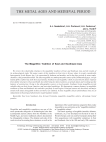
The megalithic tradition of East and Southeast Asia
Статья научная
We review the scholarship relating to the megalithic tradition of East and Southeast Asia and the results of its archaeological study. The major center of this tradition in East Asia is Korea, where it reveals considerable heterogeneity. In the Bronze Age, it is represented by dolmens and menhirs, and in the later periods by stone tombs, chambers, and pyramidal mounds. The latest megaliths are anthropomorphic statues of the Dolhareubang type, on Jeju Island off the southern tip of the Korean peninsula. Southeast Asian megaliths, which are described in detail, originate from similar structures in East and South Asia while being less known and less accurately dated, and revealing specific features of construction. Owing to the ethnographic sources on local peoples, Southeast Asian megaliths provide valuable data on their layout, function, and associated mythology. We demonstrate common features in megalithic traditions of East and Southeast Asia and their specificity in each region. Principal sources are described, and major trends in the study of megaliths in those territories are outlined. In sum, megaliths of East and Southeast Asia are an independent archaeological phenomenon requiring future studies.
Бесплатно
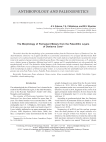
The morphology of permanent molars from the Paleolithic layers of Denisova cave
Статья обзорная
Бесплатно
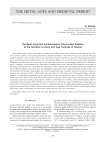
Статья научная
On the basis of the current knowledge, key archaeological discoveries made in Siberia and the Russian Far East over the three centuries, and spanning the interval from the Neolithic to the Early Iron Age, are assessed. Principal scholars and their works are listed. Rescue excavations have made it possible to construct archaeological typologies and to model historical and cultural processes. D.G. Messerschmidt’s role as the discoverer of the Early Iron Age of Khakassia and of the Tom rock art site is described. Later, this rock art site was thoroughly studied by A.P. Okladnikov and A.I. Martynov. Achievements of the 20th century continued those of the 18th and 19th centuries. On the basis of typologies elaborated by S.A. Teploukhov for Khakassia, similar cultural and chronological models for neighboring areas of Western Siberia were constructed. A.P. Okladnikov’s typology for the Cis-Baikal Neolithic and Bronze Age were elaborated by his colleagues and students. The earliest stages of the Amur Neolithic with the most ancient ceramics in Northern Asia, dating to 16,780–14,200 cal BC, were described. E.N. Chernykh’s and S.V. Kuzminykh’s theory of SeimaTurbino—a transcultural phenomenon of key importance for the Eurasian Bronze Age—is outlined. While its basic features are better known today, their theory has retained its relevance. With regard to the Early Iron Age, the major excavations concerned mounds such as Arzhan-1, Arzhan-2, and Chinge-Teya-1 in Tuva. In the Altai Mountains, likewise outstanding Pazyryk kurgans (600–200 BC) were excavated. An entirely new stage in Scythian age archaeology was marked by N.V. Polosmak’s excavations of “frozen”, undisturbed burials of middle-ranking and low-ranking Pazyryk people on the Ukok Plateau. Similar burials were excavated by Z. Samashev and H.P. Francfort on the western slopes of the Altai. Pazyryk chronology was elaborated owing to the use of the tree-ring analysis.
Бесплатно
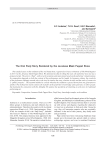
The oral Panji story rendered by the Javanese mask puppet show
Статья научная
This study focuses on the rendition of the oral Panji Story, registered in Unesco’s Memory of The Word Register in 2017, by the Javanese Mask Puppet Show. We demonstrate that in telling the story, the performer does not use a prepared script. The story is “fluid”, with several variations and innovations based on the performer’s interpretation. Its composition depends on both the context of the performance and its length. In Javanese culture, the creativity of the performer (dalang) extends only to the way he renders the story, whereas its title and the order of events are a “public property”. The nyantrik method is a mode whereby the tradition is passed down from one generation to another. The method not merely ensures the transfer of the performer’s knowledge and experience to other people, but maintains the connection with the Almighty. We analyze the specificity of rendering an oral story in traditional performing art.
Бесплатно
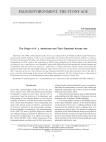
The origin of H. S. Denisovan and their dispersal across Iran
Статья научная
Before the early 2000s, anthropologists spoke of two taxa existing in the Late Middle and Early Upper Pleistocene: anatomically modern humans in Africa and Neanderthals associated with the Mousterian industry in Eurasia. Therefore, all Eurasian Paleolithic sites dating to that period were believed to be Mousterian and were associated with Neanderthals. In 2010, owing to the sequencing of mtDNA from a fragment of the distal phalanx of the hand found in Denisova Cave, a third species was introduced, genetically different from both anatomically modern humans and Neanderthals. This new taxon was termed H. s. denisovan—or simply Denisovan. Further studies showed that this population dispersed in the Late Middle and Early Upper Pleistocene across vast territories of Central and Southeast Asia. A question arose as to where Denisovans had originated and which routes they had taken to get to the Altai. A series of articles forthcoming in this journal will address these questions. The first of them focuses on the origin of Denisovans on the basis of H. heidelbergensis and on their migration via Iran to Central Asia.
Бесплатно

Статья научная
We outline the results of mineralogical and geochemical analyses of Middle Pleistocene sediments of layer 21 in the Main Chamber of Denisova Cave, Altai. The aim of the study was to reveal a set of mineralogical and trace element markers of the black-colored horizons or lenses and to distinguish them from other types of cave sediments. Results were matched with those relating to a similar set of markers of black-colored horizons in the Holocene part of the section in the East Chamber. Results indicate probable sources of organic and organogenic substances in layer 21. The preservation of geochemical marks was assessed for Pleistocene in comparison with Holocene strata, where those markers are distinct. Black-colored lenses in layer 21 resemble biogenic sediments from Holocene section of the East Chamber. Both layers are characterized by high contents of N-bearing organic matter, P, Zn, Cu, and Cd. In bulk samples from Holocene sediments, numerous fragments of chitin (insect exoskeletons) and patches of newly formed Ca and Ca-Mg phosphates were found. We conclude that these peculiar lenses consist mostly of guano from insectivorous bats, and had undergone deep biodegradation. All black-colored horizons and lenses studied in Denisova Cave have a similar set of geochemical markers and distinctly differ from the adjacent strata by their phase, macro- and trace element compositions.
Бесплатно
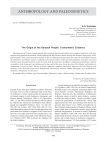
The origin of the Karasuk people: craniometric evidence
Статья научная
Measurements of 24 male cranial samples associated with the Karasuk culture were compared with those of 56 other samples using multivariate methods. On the dendrogram, the Karasuk cluster includes the Mongun-Taiga people, Saka, Sauromatians, Tauri, and a group from Sialk B. In the two-dimensional projection, this cluster is intermediate between the Andronovo and Okunev clusters, testifying to the admixed nature of the Karasuk population. In people associated with the Classic Karasuk tradition and in the north of the Karasuk area, the Okunev component predominates, whereas in members of the Kamenny Log tradition and in the south of the area, the proportion of the Okunev and Andronovo components is closer to equal. The use of twelve Andronovo samples conclusively disproves the belief that the sole ancestors of the Karasuk people were Andronovans. Mechanisms whereby Okunev aborigines were assimilated by Andronovo immigrants are discussed.
Бесплатно

